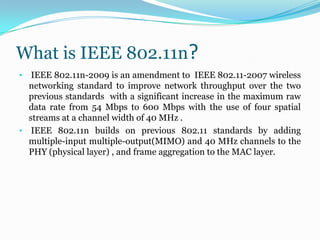IEEE 802.11n-2009 is an amendment to the wireless networking standard aimed at improving network throughput by increasing data rates from 54 Mbps to 600 Mbps using MIMO technology and 40 MHz channels. The document outlines the advancements made over previous standards, including MAC layer enhancements and various modulation techniques, while also discussing compatibility and deployment challenges. It highlights the potential applications of 802.11n in enhancing wireless access for devices like laptops and smartphones.






















